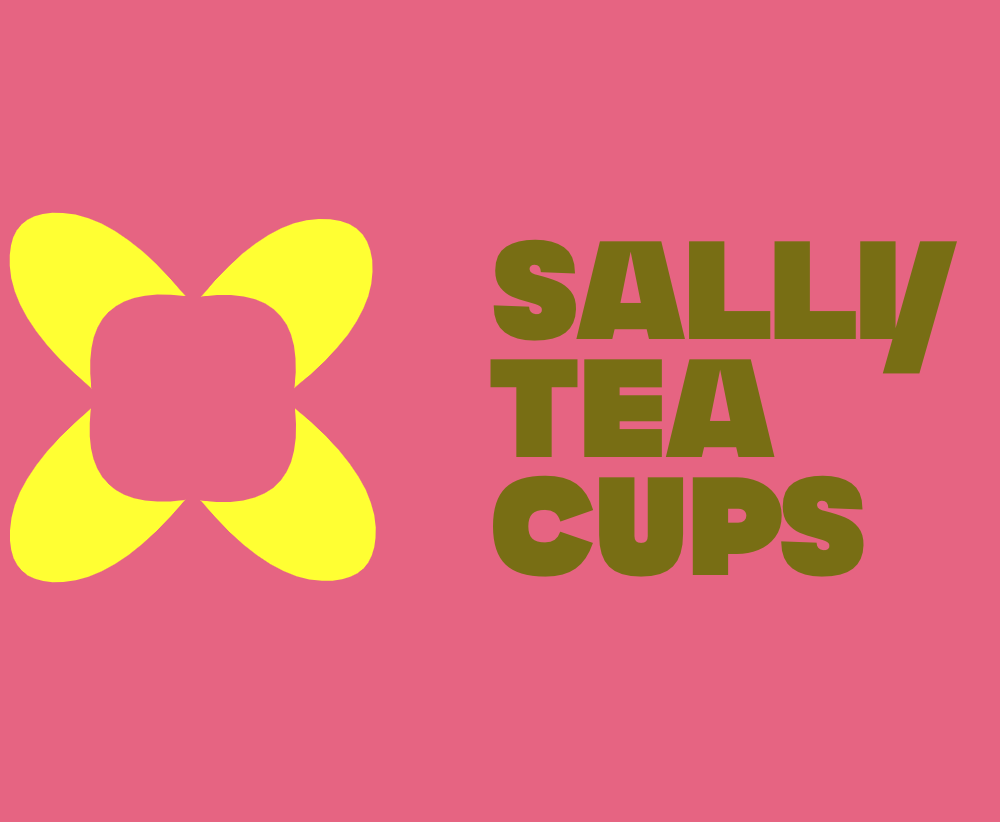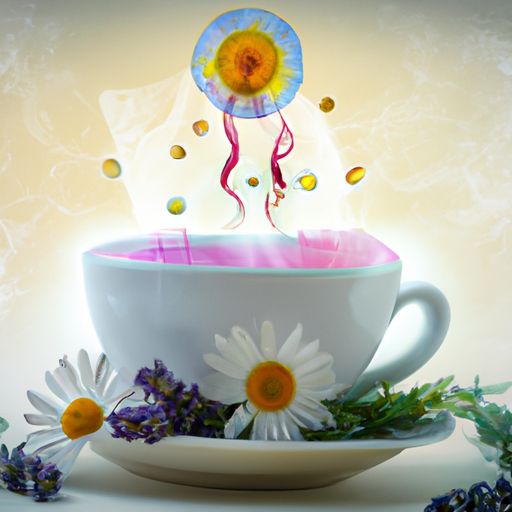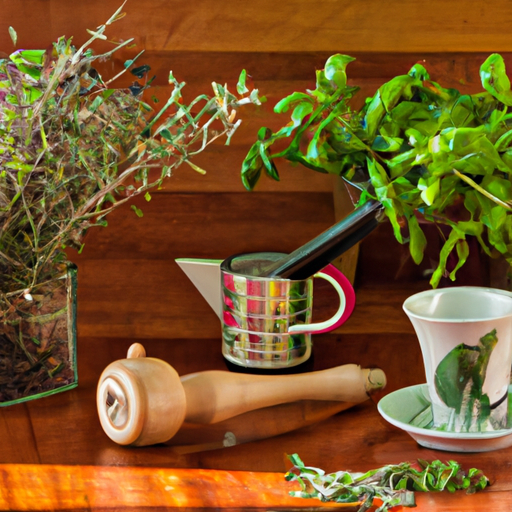Tea Brewing and Preparation
What Is The Difference Between Black Tea And Herbal Tea
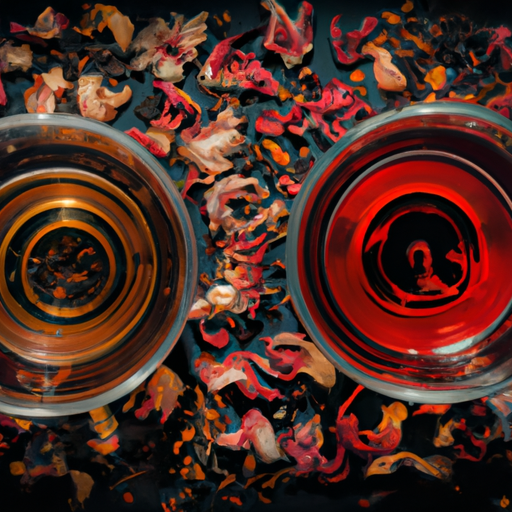
Black tea and herbal tea may both be steeped in hot water, but they are as different as night and day. Like two sides of a coin or the sun and the moon, black tea and herbal tea offer distinct flavors and health benefits. Understanding the differences between these two popular beverages can help you make an informed choice when deciding which one to sip on.
Black tea, like a strong oak tree, is derived from the Camellia sinensis plant and undergoes a process of withering, rolling, oxidation, and drying. This process gives black tea its bold and robust flavor, along with a moderate amount of caffeine.
On the other hand, herbal tea, like a vibrant wildflower field, is made from various plants and herbs, such as chamomile, peppermint, or hibiscus. Herbal teas are naturally caffeine-free and offer a wide range of flavors, from soothing and calming to invigorating and refreshing.
So, whether you crave the rich and energizing taste of black tea or the gentle and diverse flavors of herbal tea, understanding the differences between the two will help you choose the perfect cup for any occasion.
Key Takeaways
- Black tea is derived from the Camellia sinensis plant and undergoes a process of withering, rolling, oxidation, and drying, while herbal tea is made from various plants and herbs.
- Black tea contains a moderate amount of caffeine, while herbal tea is naturally caffeine-free, making herbal tea a great alternative for those looking to reduce their caffeine intake.
- Black tea undergoes a complete oxidation process, giving it a bold, rich, and full-bodied taste, while herbal tea offers a wide range of flavors, from floral to fruity to spicy.
- Herbal tea is packed with antioxidants, vitamins, and minerals, making it a healthy choice that can potentially reduce the risk of chronic diseases.
The Origins of Black Tea and Herbal Tea
Imagine yourself sitting in a cozy tea shop, sipping on a warm cup of black tea or herbal tea, while learning about their fascinating origins.
Black tea, also known as fully oxidized tea, originates from the Camellia sinensis plant. It was first cultivated in China and later spread to other parts of the world, including India, Sri Lanka, and Kenya. Black tea has a long history and cultural significance in many countries, with unique tea-drinking customs and ceremonies. Its production has had a significant impact on local economies, providing employment opportunities and contributing to international trade.
On the other hand, herbal tea is not derived from the Camellia sinensis plant but from various herbs, flowers, fruits, and spices. Unlike black tea, herbal tea does not contain caffeine. It has been consumed for centuries for its medicinal properties and soothing effects. Herbal teas have cultural significance in different regions, often used in traditional remedies and ceremonies.
Now, let’s explore the processing methods that differentiate black tea and herbal tea.
The Processing Methods
To understand the processing methods of black tea and herbal tea, picture yourself witnessing the transformation of tea leaves into two distinct forms. Here’s a step-by-step breakdown of the oxidation process and drying methods that differentiate these two types of tea:
-
Oxidation Process: Black tea undergoes a complete oxidation process, while herbal tea does not. After the leaves are plucked, they are spread out and exposed to air. Enzymes in the leaves react with oxygen, causing them to darken in color and develop rich flavors. This process is crucial in creating the characteristic bold and robust taste of black tea.
-
Drying Methods: Once the desired level of oxidation is reached, the leaves are dried to halt the oxidation process. Black tea is typically dried using high heat or by placing the leaves in large ovens. This ensures that the leaves are fully dried, preserving their flavor and preventing spoilage. In contrast, herbal tea is often air-dried or gently heated to preserve the delicate flavors and aromas of the herbs and botanicals used.
Understanding the processing methods sheds light on the distinct flavor profiles of black tea and herbal tea. Let’s delve into these flavor profiles in the next section.
The Flavor Profiles
When it comes to the flavor profiles of black tea and herbal tea, there are distinct differences that make each unique.
Black tea is known for its bold, rich, and full-bodied taste, which comes from the fermentation process it undergoes.
On the other hand, herbal tea offers a wide range of flavors, from floral to fruity to spicy, depending on the herbs and botanicals used in its preparation.
These varying flavor profiles make herbal tea a versatile and enjoyable choice for those looking for a more diverse tea experience.
Black Tea – Bold, Rich, and Full-Bodied
Savor the essence of a dark, velvety elixir that dances on your palate, as black tea unveils its bold, rich, and full-bodied symphony of flavors.
Black tea, derived from the leaves of the Camellia sinensis plant, undergoes a unique brewing process that sets it apart from herbal teas. The leaves are withered, rolled, oxidized, and then dried, resulting in a deep amber liquor that exudes an enticing aroma.
One can easily distinguish black tea from other types of tea by its robust and intense flavor, which can range from malty and earthy to smoky and fruity. Its deep color, ranging from coppery red to dark brown, adds to its allure.
As we transition to the subsequent section about herbal tea – varied flavors, from floral to fruity to spicy – it is important to note that the brewing process and color are just the beginning of the distinctions between these two tea varieties.
Herbal Tea – Varied Flavors, from Floral to Fruity to Spicy
Indulge in the diverse array of flavors found in herbal tea, ranging from delicate floral notes to vibrant fruity bursts and even fiery spices.
Herbal tea is a delightful option for those with specific flavor preferences or health concerns. For those who enjoy a light and refreshing taste, there are herbal teas infused with chamomile or lavender, offering a calming and soothing experience.
If you prefer a burst of fruitiness, teas with hibiscus or citrus flavors can be a great choice. For those who crave a bit of spice, herbal teas with ingredients like ginger or cinnamon can provide a warming and invigorating sensation.
Whether you are seeking a tea to wind down after a long day or a tea to accompany a meal, herbal tea offers an endless variety of flavors to suit your taste.
Now, let’s explore the caffeine content of these teas.
The Caffeine Content
If you’re looking to cut back on your caffeine intake, herbal tea is the way to go. It won’t give you that jittery feeling like black tea. While black tea contains caffeine, herbal teas are naturally caffeine-free. This makes them a great alternative for those who are sensitive to or trying to reduce their caffeine consumption.
The caffeine in black tea can have various effects on the body. It can increase heart rate and blood pressure, as well as interfere with sleep patterns. On the other hand, herbal tea brings a host of benefits without the caffeine. It is known for its calming properties, which can help with relaxation and sleep.
Additionally, herbal teas are often made from various herbs, flowers, and fruits, resulting in a wide range of flavors and aromas. From floral to fruity to spicy, there is an herbal tea to suit every taste preference. These teas can also provide additional health benefits, which we’ll explore further in the next section about their overall health benefits.
Health Benefits
Experience the incredible array of health benefits that herbal tea has to offer, from boosting the immune system to soothing digestion and promoting overall well-being. Herbal teas are not only delicious and comforting, but they also provide a variety of essential nutrients that can contribute to a healthy lifestyle.
Here are the nutritional differences between black tea and herbal tea:
-
Antioxidant-rich: Herbal teas are packed with antioxidants that help protect the body against damage from free radicals. These antioxidants can reduce the risk of chronic diseases like heart disease and certain types of cancer.
-
Vitamin and mineral content: Herbal teas are a great source of vitamins and minerals, depending on the herbs used. For example, chamomile tea contains calcium, magnesium, and potassium, which are essential for bone health and muscle function.
-
Calorie-free and caffeine-free: Unlike black tea, herbal teas are calorie-free and naturally caffeine-free. This makes them an excellent choice for those looking to reduce their caffeine intake or for individuals who are sensitive to caffeine.
While herbal teas offer numerous health benefits, it’s important to note that some herbs may have potential side effects or interact with certain medications. It’s always best to consult with a healthcare professional before incorporating herbal teas into your daily routine.
Transitioning to brewing and serving methods, let’s explore how to make the perfect cup of herbal tea.
Brewing and Serving Methods
Get ready to discover the secrets of brewing and serving the perfect cup of herbal tea to enhance your enjoyment and relaxation. When it comes to herbal teas, there are several alternative brewing methods that can bring out the best flavors and aromas. One popular method is the infusion method, where you simply pour hot water over the tea leaves and let it steep for a few minutes. Another option is the cold brew method, which involves steeping the tea leaves in cold water overnight for a refreshing and milder taste. Lastly, you can also try the decoction method, where you simmer the tea leaves in water for a longer period of time to extract more concentrated flavors.
To help you choose the best brewing method for your herbal tea, here is a table outlining the recommended brewing times and temperatures for three common herbal teas:
| Herbal Tea | Brewing Time | Water Temperature |
|---|---|---|
| Chamomile | 5-7 minutes | 200°F |
| Peppermint | 3-5 minutes | 212°F |
| Rooibos | 5-7 minutes | 212°F |
Pairing herbal tea with food can also enhance your overall tea experience. For example, chamomile tea pairs well with light and sweet desserts, while peppermint tea complements chocolate-based treats. Rooibos tea, with its earthy flavor, goes well with savory dishes like grilled meats or roasted vegetables.
Now that you know how to brew and serve herbal tea, let’s explore the popular varieties and blends that you can enjoy in the next section.
Popular Varieties and Blends
Let’s dive into the world of popular herbal tea varieties and blends that’ll take your tea-drinking experience to the next level!
When it comes to herbal teas, there’s an endless variety of flavors and blends to choose from. From soothing chamomile to invigorating peppermint, each herbal tea offers its own unique taste and benefits.
One of the great things about herbal teas is that they can be brewed using different techniques. Some teas are best steeped in boiling water, while others require a gentler infusion. Experimenting with brewing times and temperatures can help you find the perfect cup of herbal tea that suits your taste preferences.
Herbal teas also have a rich history in various cultures around the world. Different cultures have their own traditional herbal teas that are deeply embedded in their culinary and medicinal practices. For example, in China, herbal teas like chrysanthemum tea and ginseng tea have been enjoyed for centuries for their health benefits. In India, Ayurvedic herbal teas, such as turmeric tea and tulsi tea, are popular for their healing properties.
Exploring the world of herbal tea is a delightful journey that offers a multitude of flavors and blends. By trying different brewing techniques and exploring the tea and culture behind each herbal tea, you can truly elevate your tea-drinking experience. So, go ahead and indulge in the wonderful world of herbal teas!
Frequently Asked Questions
Are there any potential side effects of consuming black tea or herbal tea?
There are potential risks associated with consuming black tea or herbal tea, including caffeine sensitivity, digestive issues, and interactions with certain medications. Long-term effects may vary depending on individual health factors.
Can black tea or herbal tea help with weight loss?
Black tea and herbal tea can aid in weight loss. Black tea contains caffeine and can boost metabolism, while herbal teas like green tea have catechins that help burn fat. Incorporating these teas into a healthy diet can support weight loss goals.
Are there any age restrictions for consuming black tea or herbal tea?
There are no age restrictions for consuming black tea or herbal tea. Both have health benefits, such as antioxidants and potential weight loss aid. However, it’s important to moderate caffeine intake for children and pregnant women.
Can black tea or herbal tea be consumed during pregnancy or breastfeeding?
During pregnancy, it is generally safe to consume black tea in moderation, as it contains caffeine. However, herbal teas should be consumed with caution, as some herbs may not be safe. It’s important to consult with a healthcare provider for specific recommendations.
What is the recommended daily intake of black tea or herbal tea for optimal health benefits?
The recommended daily intake of black tea or herbal tea for optimal health benefits varies depending on individual factors. It is best to consult with a healthcare professional to determine the appropriate amount for you.
Conclusion
In conclusion, knowing the difference between black tea and herbal tea allows us to savor the subtle nuances of each sip.
The origins, processing methods, flavor profiles, and caffeine content all contribute to their unique characteristics.
While black tea offers a bold and robust flavor, herbal tea provides a refreshing and diverse range of flavors.
Both types also offer various health benefits.
So, whether you prefer the invigorating allure of black tea or the soothing symphony of herbal tea, indulge in a cup that caters to your cravings and captivates your senses.
Tea Brewing and Preparation
The Enchanting Tea Regions Of India: Darjeeling, Assam, Nilgiri, And More
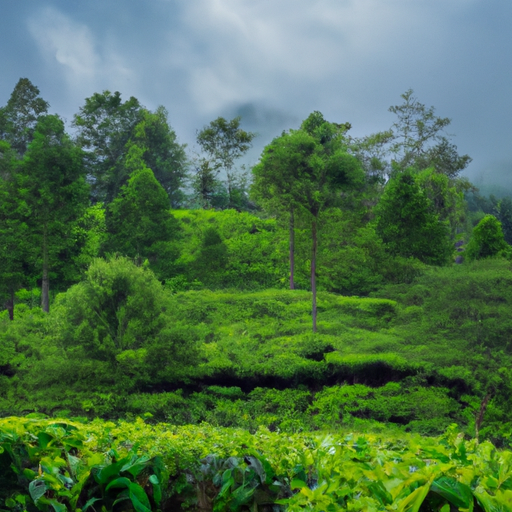
Are you prepared to explore the mesmerizing tea regions of India? Prepare yourself for a sensory experience filled with a variety of flavors, aromas, and fascinating history.
Imagine sipping a cup of tea as the sun rises over the misty hills of Darjeeling, or savoring a bold and brisk Assam tea that awakens your taste buds with its malty smoothness.
Picture yourself surrounded by the fragrant tea gardens of Nilgiri, where every sip offers a bright and invigorating experience.
But the magic doesn’t stop there – India has even more tea treasures to discover, from the serene landscapes of Sikkim to the neighboring tea estates in Nepal and Dooars.
As a tea lover, I can assure you that these regions hold a world of wonder and excitement.
So join me as we explore the diverse and captivating tea regions of India, where every cup tells a story of tradition, craftsmanship, and the purest essence of nature.
Get ready to be enchanted by the flavors and aromas that await you in the land of tea.
Key Takeaways
- Tea regions of India: Darjeeling, Assam, Nilgiri, and Sikkim
- Each region has unique characteristics in terms of climate, altitude, and terrain.
- Indian tea has a significant cultural and historical significance.
- Online shops offer a wide selection of high-quality loose leaf teas from India.
Main Tea Growing Regions
I’ve learned that the main tea growing regions in India include Darjeeling, Assam, Nilgiri, and Sikkim. Each of these regions produces teas that have their own unique flavors and characteristics, making them truly enchanting.
The cultural significance of tea in India is immense, as it’s not just a beverage but a part of everyday life and an integral part of Indian customs and traditions.
The environmental factors affecting tea production in these regions vary, resulting in teas with distinct qualities. In Darjeeling, the high altitude and cool climate create a delicate and fruity essence in the tea, similar to the experience of sipping champagne. Assam, on the other hand, with its low-lying plains and warm, humid climate, produces teas with a bold and brisk flavor, along with a warm malty smoothness. Nilgiri, with its cool, mountainous terrain, gives birth to teas with a bright, brisk, and fragrant flavor. Sikkim, nestled in the Himalayas, produces teas that are delicate and aromatic.
Exploring the enchanting tea regions of India is truly a remarkable experience, as you get to taste the diverse flavors and learn about the rich cultural heritage associated with each region.
Characteristics of Indian Teas
Known for their distinct flavors and unique characteristics, Indian teas from renowned growing regions captivate tea enthusiasts with their delicate and fruity essence, bold and brisk flavors, and fragrant, bright profiles, making them a delightful addition to any tea collection.
The Indian tea grading system plays a significant role in categorizing these teas based on size and shape, rather than quality or taste. This system includes whole leaf grades such as SFTGFOP, FTGFOP, TGFOP, GFOP, FOP, and OP, as well as broken leaf grades like GFBOP, GBOP, FBOP, and BOP.
The history of tea production in India is intertwined with the British East India Company, which played a pivotal role in commercializing tea cultivation in the country. Today, India stands as the second-largest tea producer in the world, after China.
With the availability of quality loose leaf Indian teas online, tea lovers can easily explore and experience the enchanting flavors of Darjeeling, Assam, Nilgiri, and other tea-growing regions in India.
Where to Buy Indian Tea
For those looking to purchase Indian tea, there are several online shops that offer a wide selection of high-quality loose leaf teas from various estates and growing regions. Some of the best online retailers for Indian tea include Vahdam Tea, Teabox, Adagio Tea, Palais des Thés, and The Tea Spot. These shops specialize in sourcing and curating the finest Indian teas, providing customers with a diverse range of options to choose from. From the delicate and fruity essence of Darjeeling tea to the bold and brisk flavor of Assam tea, each region offers unique flavors that are a true delight for tea enthusiasts. Whether you prefer the bright and fragrant Nilgiri tea or the strong and flavorful CTC tea, these online retailers have something to satisfy every palate. So, explore the enchanting tea regions of India and experience the rich flavors that Indian teas have to offer.
Frequently Asked Questions
What is the historical significance of the British East India Company in relation to tea production in India?
The British East India Company had a significant historical impact on tea production in India. Their commercialization efforts led to economic implications, making India the second-largest tea producer in the world.
How does the British grading system categorize tea in India?
The British grading system categorizes tea in India based on size and shape, rather than quality or taste. It includes categories like SFTGFOP, FTGFOP, TGFOP, GFOP, FOP, OP for whole leaf teas and GFBOP, GBOP, FBOP, BOP for broken leaf teas.
What is the CTC method of processing black tea and why is it commonly used for tea bags?
The CTC method of processing black tea is like a powerful whirlwind that crushes, tears, and curls the leaves, creating a bold and robust flavor. This method is commonly used for tea bags because it produces a quicker infusion and stronger taste.
What is masala chai and why is it popular in India?
Masala chai is a popular spiced tea in India known for its rich flavors and aromatic spices. It is loved for its warming and comforting qualities, and is believed to offer various health benefits, such as aiding digestion and boosting immunity.
How does India’s tea production compare to China’s in terms of quantity?
India’s tea production is second only to China, but it’s not just about quantity. Factors like climate, soil, and skilled labor play a vital role. India’s diverse tea regions make it a powerhouse in the tea industry.
Conclusion
In conclusion, the enchanting tea regions of India, such as Darjeeling, Assam, and Nilgiri, offer a diverse range of flavors and characteristics that are sure to captivate any tea lover.
While some may argue that buying Indian tea online lacks the personal touch of visiting a physical store, let me paint a picture for you. Imagine sitting in your cozy corner, sipping a delicate and fruity Darjeeling tea or a bold and brisk Assam tea, while the aroma fills the air.
With just a few clicks, you can explore the wide selection of quality loose leaf Indian teas from reputable online shops like Vahdam Tea, Teabox, Adagio Tea, Palais des Thés, and The Tea Spot.
Don’t let distance hinder you from experiencing the magic of Indian teas; let them transport you to the picturesque tea gardens of India, right in the comfort of your own home.
Tea Brewing and Preparation
The Ultimate Guide To Perfecting Earl Grey Tea
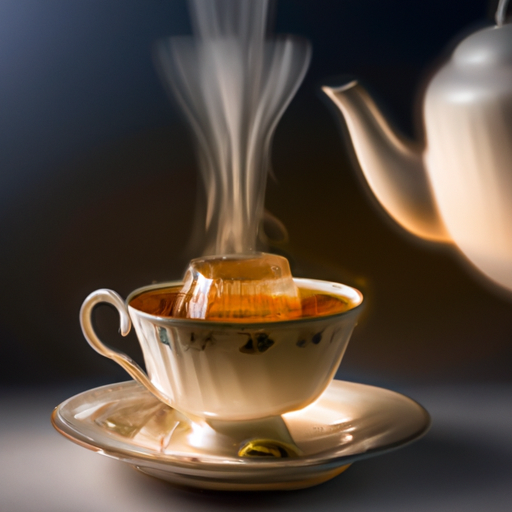
Hey tea lovers! Ready to elevate your Earl Grey tea experience? Look no further! Check out this ultimate guide to mastering the art of this popular and delicious tea.
As the saying goes, ‘The proof is in the pudding,’ and when it comes to Earl Grey tea, the proof is definitely in the blend. With its origins dating back to the 1830s, this tea is named after the second Earl of Grey, and its distinctive flavor comes from a combination of black tea and bergamot oil. But not all Earl Grey teas are created equal!
In this guide, I’ll walk you through the different types of Earl Grey tea available, from Earl Grey White to Earl Grey Lavender, so you can find the perfect one for your taste buds. We’ll also explore the best Earl Grey brands that use natural bergamot oil, like Smith Teamaker and Rishi.
But it doesn’t stop there! I’ll also delve into the health benefits of bergamot, including its aid in digestion and protection of the stomach lining. And of course, I’ll provide you with precise brewing instructions, tailored to the type of tea base you choose, whether it’s black, green, white, or rooibos tea.
So grab your favorite teapot and get ready to embark on a journey to tea perfection with this ultimate guide to Earl Grey tea. Let’s brew it right!
Key Takeaways
- Earl Grey tea is named after Charles Grey, the second Earl of Grey and British Prime Minister in the 1830s.
- The flavor of Earl Grey tea is greatly affected by the choice and amount of bergamot oil used.
- The best Earl Grey brands use natural bergamot oil, preferably from Italy.
- Earl Grey tea can be brewed with different types of tea as a base, such as black, green, white, or rooibos tea.
Types of Earl Grey Tea
I love exploring the different types of Earl Grey tea, such as Earl Grey White, Lapsang Souchong, Blue Cornflowers, and Earl Green, among others, to find the perfect blend for my taste.
These varieties of Earl Grey tea have gained popularity due to their unique flavors and aromas. Earl Grey White tea is a delicate and light version that combines the floral notes of white tea with the citrusy bergamot flavor. Lapsang Souchong Earl Grey offers a smoky twist to the traditional blend, while Blue Cornflowers Earl Grey adds a vibrant visual appeal. Earl Green tea infuses the classic Earl Grey taste into a refreshing green tea base.
With so many options available, there is an Earl Grey tea for every tea enthusiast to enjoy.
Best Earl Grey Brands
Adagio, Fortnum & Mason, Kusmi Tea, Teabox, Smith Tea, and Vahdam Teas are the absolute best Earl Grey brands that will blow your taste buds away. Here are three reasons why these brands stand out in the world of Earl Grey tea:
-
Earl Grey tea flavors: Each of these brands offers a wide range of Earl Grey tea flavors to suit every palate. From classic Earl Grey with its bold bergamot flavor to unique variations like Earl Grey Lavender or Russian Earl Grey, there’s something for everyone.
-
Earl Grey tea origins: These brands take pride in sourcing high-quality ingredients for their Earl Grey teas. They use natural bergamot oil, preferably from Italy, to ensure an authentic and delightful citrus flavor. The black tea base is a blend of Darjeeling, Assam, and Ceylon tea, creating a rich and robust infusion.
-
Reputable tea brands: Adagio, Fortnum & Mason, Kusmi Tea, Teabox, Smith Tea, and Vahdam Teas are well-known and respected in the tea industry. They have a reputation for producing top-notch teas and providing exceptional customer service. With their commitment to quality, you can trust that you’re getting the best Earl Grey tea experience possible.
When it comes to Earl Grey tea, these brands are the crème de la crème. Give them a try, and you won’t be disappointed.
Health Benefits of Bergamot
Bergamot offers a range of health benefits, including aiding digestion and protecting the stomach lining. This Mediterranean citrus fruit is not only known for its distinctive flavor in Earl Grey tea, but also for its positive impact on our well-being. Bergamot cultivation is primarily found in southern Italy, particularly in the Calabria region. In addition to its use in tea, bergamot is also widely used in culinary applications. Its zesty and aromatic qualities make it a popular ingredient in various dishes, desserts, and beverages. The unique combination of citrus and floral notes adds a refreshing touch to salads, cocktails, and even ice cream. Moreover, bergamot has been found to have antioxidant properties and may support cardiovascular health. So, not only does bergamot enhance the flavor of Earl Grey tea, but it also brings numerous health benefits to the table.
| Health Benefits of Bergamot | Culinary Applications of Bergamot |
|---|---|
| Aids digestion | Adds zest to salads |
| Protects stomach lining | Enhances cocktails |
| Antioxidant properties | Refreshes ice cream |
| Supports cardiovascular health | Adds flavor to various dishes |
Brewing Instructions
To brew a delicious cup of Earl Grey tea, start by bringing water to a boil and then steeping the tea for 5 minutes if you’re using a black or rooibos tea base, or 3 minutes if you’re using a white or green tea base.
The choice of tea base can greatly influence the flavor of your Earl Grey tea. Black or rooibos tea provides a stronger and bolder taste, while white or green tea offers a lighter and more delicate flavor profile. It’s important to note that the water temperature should be 212°F (100°C) for black or rooibos tea, and 175°F (80°C) for white or green tea. This ensures that the tea leaves release their flavors properly, resulting in a perfectly balanced cup of Earl Grey tea.
Frequently Asked Questions
What are some creative ways to use Earl Grey tea besides drinking it?
Using Earl Grey Tea in recipes is a great way to add a unique flavor. Infuse desserts like Earl Grey tea cake, Earl Grey panna cotta, or Earl Grey macarons for a delicious twist.
Does the quality of the water used affect the flavor of Earl Grey tea?
Oh, you won’t believe the incredible impact that water quality has on the flavor of Earl Grey tea! Brewing temperatures and steeping time also work their magic, creating a taste profile that’s simply divine. It’s all about precision and knowledge, my friend.
Can you add milk or sweeteners to Earl Grey tea?
Yes, you can add milk or sweeteners to Earl Grey tea. Milk can help mellow the strong flavors and add a creamy texture, while sweeteners like honey or sugar can enhance the tea’s natural sweetness. Alternatively, you can try lemon or a dash of vanilla for a different twist.
How long can Earl Grey tea be stored before it goes bad?
Storing Earl Grey tea is like preserving a fragrant memory. To keep it fresh, store it in an airtight container away from light, heat, and moisture. To determine if it has gone bad, trust your senses—look for any signs of mold, off smells, or a stale taste.
Are there any specific food pairings that go well with Earl Grey tea?
Food pairings for Earl Grey tea include lemon pastries, shortbread cookies, and scones. The citrus flavors complement the bergamot in the tea. Health benefits of drinking Earl Grey tea include aiding digestion and protecting the stomach lining.
Conclusion
In conclusion, perfecting the art of brewing Earl Grey tea is an essential skill for tea enthusiasts. By understanding the various types of Earl Grey tea available and choosing the best brands that use natural bergamot oil, one can truly experience the exquisite flavors and aromas this tea has to offer.
Despite concerns about the brewing process, rest assured that with the right instructions, anyone can achieve a delicious cup of Earl Grey tea. So why not indulge in this delightful beverage and savor the comforting warmth it brings to your senses?
Tea Brewing and Preparation
The Ultimate Guide To Choosing The Perfect Tea Kettle
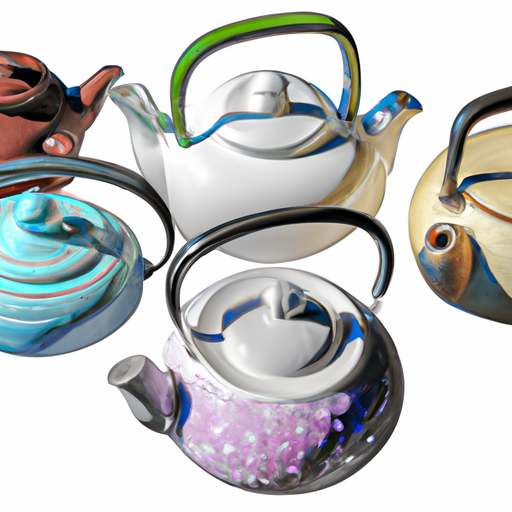
Are you fed up with always drinking mediocre tea? Then you need to check out ‘The Ultimate Guide to Choosing the Perfect Tea Kettle.’
This comprehensive article is the holy grail for tea enthusiasts, offering an unrivaled selection of the best tea kettles in 2023. With painstaking research and input from fellow tea lovers, I have curated a list of the top 10 kettles that will revolutionize your tea brewing experience.
Whether you prefer electric or stovetop, large or small, we have got you covered. But wait, there’s more! We delve into the nitty-gritty details, discussing crucial factors like size, water temperature control, material, and style.
Plus, we reveal the crème de la crème, including the best tea kettle overall and the best ones with an infuser.
Don’t settle for subpar tea any longer – join the tea revolution with our ultimate guide!
Key Takeaways
- The article provides a comprehensive list of the best tea kettles for better tea in 2023, catering to different preferences and budgets.
- The author has personally tested and recommends the Breville Smart Tea Infuser and the Le Creuset Enamel On Steel Whistling Tea Kettle.
- Amazon carries many unfamiliar brands, but the author has researched and found the best kettles reviewed by real customers and tea enthusiasts.
- Factors to consider when buying a tea kettle include size, water temperature control, price, material, weight, and style.
Top Tea Kettle Options
I’ve found some great options for tea kettles based on my research and input from tea enthusiasts. When it comes to tea kettles, one important factor to consider is the size.
Fortunately, there are different size options available to suit your needs. For those on a budget, I recommend the best budget kettle, which is the AmazonBasics Electric Tea Kettle. It may be affordable, but it doesn’t compromise on quality. This kettle is small and quick to boil water, making it perfect for individuals or small households. It also has an automatic shut-off feature for added safety.
So, if you’re looking for a tea kettle that won’t break the bank, the AmazonBasics Electric Tea Kettle is a great choice.
Factors to Consider
With so many tea kettles to choose from, finding the one that suits your preferences and budget is like navigating a steaming sea of possibilities.
When it comes to brewing the perfect cup of tea, water temperature is crucial. Different types of tea require different water temperatures for optimal flavor extraction. That’s why it’s important to choose a tea kettle that allows you to control the water temperature.
As for the materials, each has its pros and cons. Stainless steel kettles are durable and easy to clean, but they can take longer to heat up. Glass kettles are aesthetically pleasing and allow you to see the water boiling, but they can be fragile. Ceramic kettles retain heat well, but they can be heavy.
Consider these factors when choosing the perfect tea kettle for your tea brewing needs.
Recommended Electric Kettle
When it comes to electric kettles, the Breville Electric Kettle is highly recommended for its exceptional performance and features.
-
The Breville Electric Kettle has received high ratings and positive customer reviews for its fast boiling time, making it perfect for those who’re always on the go.
-
This kettle also offers temperature control settings, allowing you to choose the perfect temperature for different types of teas.
-
With its sleek design and stainless steel construction, the Breville Electric Kettle isn’t just functional but also aesthetically pleasing.
-
The kettle also features a convenient cordless design and a 360-degree swivel base, making it easy to pour and serve.
Customers have praised the Breville Electric Kettle for its durability, ease of use, and precise temperature control. It’s no wonder why this kettle is a top choice among tea enthusiasts.
Best Stovetop Kettle
The SUSTEAS Stovetop Whistling Tea Kettle has been recognized as the best-selling stovetop kettle on Amazon, with its popularity backed by its near-perfect ratings from satisfied customers.
When choosing the right stovetop kettle for your needs, there are a few key features to consider. Firstly, think about the material of the kettle. Stainless steel is a popular choice for its durability, while copper kettles are known for their excellent heat conductivity.
Additionally, consider the size and capacity of the kettle. If you often make tea for a large group, a larger kettle may be more suitable.
Other features to look for include a whistling mechanism to alert you when the water is boiling, a heat-resistant handle for safe pouring, and a removable lid for easy cleaning.
By considering these factors, you can find the perfect stovetop kettle to enhance your tea-making experience.
Decorative Tea Kettle
I personally love a decorative tea kettle to add a touch of elegance to my tea brewing routine. A decorative tea kettle not only serves as a functional tool for boiling water but also acts as a beautiful centerpiece in my kitchen. Here are some benefits of having a decorative tea kettle:
- Aesthetic Appeal: A decorative tea kettle adds a pop of color and style to any kitchen décor.
- Conversation Starter: Guests are often intrigued by the unique designs and intricate details of a decorative tea kettle, making it a great conversation starter.
- Personal Expression: Choosing a decorative tea kettle that reflects your personal style allows you to showcase your taste and personality.
- Gift-Worthy: A decorative tea kettle makes a thoughtful and impressive gift for tea enthusiasts or as a housewarming present.
- Versatility: Even when not in use, a decorative tea kettle can be displayed as a decorative piece, enhancing the overall ambiance of your kitchen.
To ensure the longevity and beauty of a decorative tea kettle, here are some maintenance tips:
- Handwashing: Decorative tea kettles are often made of delicate materials, so it’s best to hand wash them with a mild detergent and a soft cloth.
- Avoid Abrasive Cleaners: Harsh chemicals and abrasive cleaners can damage the finish and design of a decorative tea kettle, so it’s important to avoid them.
- Regular Polishing: To keep the shine and luster of a decorative tea kettle, periodically polish it with a non-abrasive metal polish.
- Handle with Care: When handling a decorative tea kettle, be mindful of its delicate features and avoid any rough or forceful actions.
- Proper Storage: When not in use, store your decorative tea kettle in a safe and dry place to prevent any damage or tarnishing.
Incorporating a decorative tea kettle into your tea brewing routine not only adds visual appeal but also enhances the overall tea-drinking experience.
Frequently Asked Questions
What are the benefits of using a tea kettle over a regular pot to boil water for tea?
Using a regular pot to boil water for tea is like using a rusty old bicycle to race in the Tour de France. A tea kettle, on the other hand, offers precise temperature control, quick boiling, and a whistle to alert you when it’s ready. It’s the Ferrari of tea brewing.
Can I use a tea kettle on an induction cooktop?
Yes, you can absolutely use a tea kettle on an induction cooktop. Induction cooktops work by creating a magnetic field, which heats up the kettle through induction. It is a safe and efficient method for heating water.
How do I clean and maintain a tea kettle?
To clean and maintain a tea kettle, start by filling it with equal parts water and vinegar and bringing it to a boil. Then, let it sit for 30 minutes before rinsing thoroughly. Regularly descale and dry the kettle to prevent mineral buildup and rust.
Are there any safety features to look for in a tea kettle?
Tea kettle safety features are crucial for a worry-free tea experience. Look for kettles with automatic shut-off, boil-dry protection, and insulated handles to prevent burns. Insulation is important for heat retention and keeping the exterior cool to touch.
Can I use a tea kettle to heat other beverages besides tea?
Yes, you can use a tea kettle to heat other beverages besides tea. Tea kettles are versatile and can be used to heat coffee, hot chocolate, and other beverages. They are a handy tool in the kitchen for various hot drinks.
Conclusion
Well, there you have it – the ultimate guide to choosing the perfect tea kettle.
With our carefully curated list of top options, along with the factors to consider, you’re now equipped to make the best decision for your tea brewing needs.
Whether you prefer an electric kettle or a stovetop one, we’ve got you covered. And who says a tea kettle can’t be both functional and decorative?
So go ahead, elevate your tea experience and impress your guests with a kettle that not only brews the perfect cup but also adds a touch of style to your kitchen.
Happy tea brewing!
-

 Tea and Philosophy3 months ago
Tea and Philosophy3 months agoLinkBoss Revolutionizes Interlinking Strategy for WordPress Sites
-
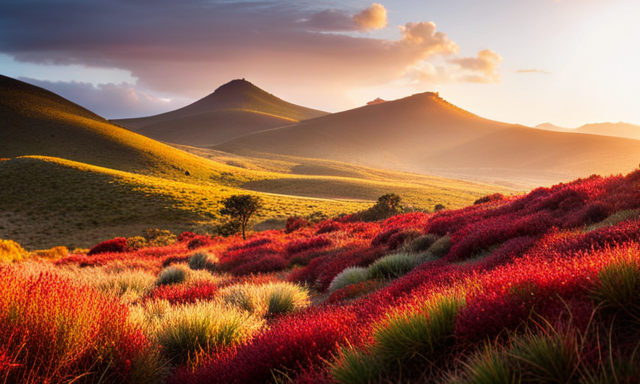
 Rooibos Tea3 months ago
Rooibos Tea3 months agoRooibos Where It Comes From
-
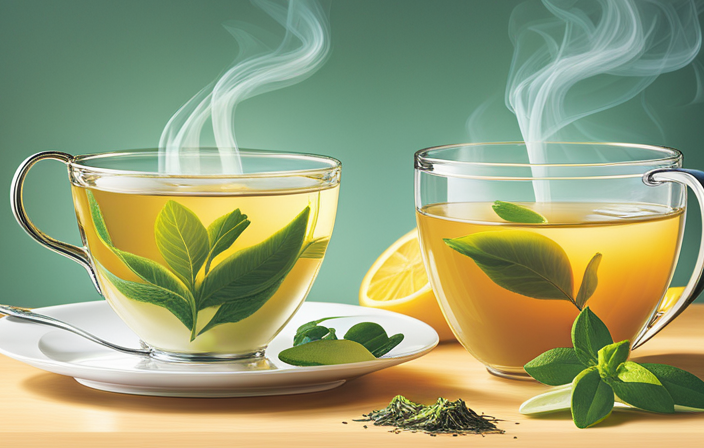
 Green Tea3 months ago
Green Tea3 months agoWhat Factors Contribute to the Sometimes Bitter Taste of Green Tea?
-
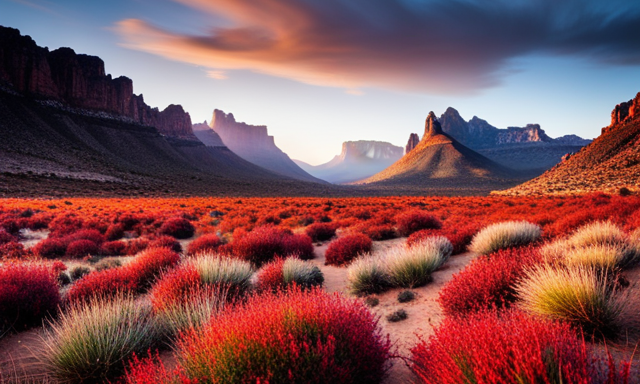
 Rooibos Tea3 months ago
Rooibos Tea3 months agoWhere Does Rooibos Come From?
-
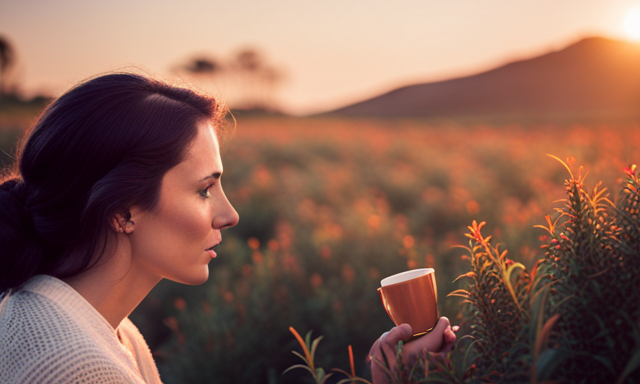
 Rooibos Tea3 months ago
Rooibos Tea3 months agoIs Rooibos Teas Good For When You’re On Your Period
-
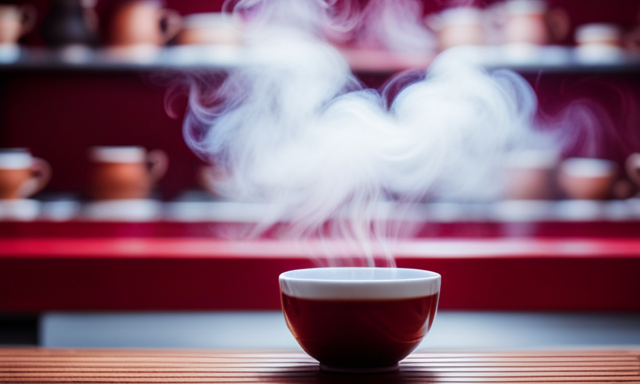
 Rooibos Tea3 months ago
Rooibos Tea3 months agoHow Many Times A Day Can You Drink Rooibos Tea
-
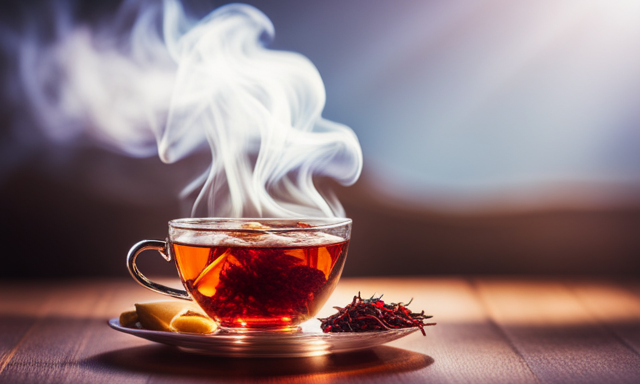
 Rooibos Tea3 months ago
Rooibos Tea3 months agoWhat Are Rooibos Tea Benefits
-
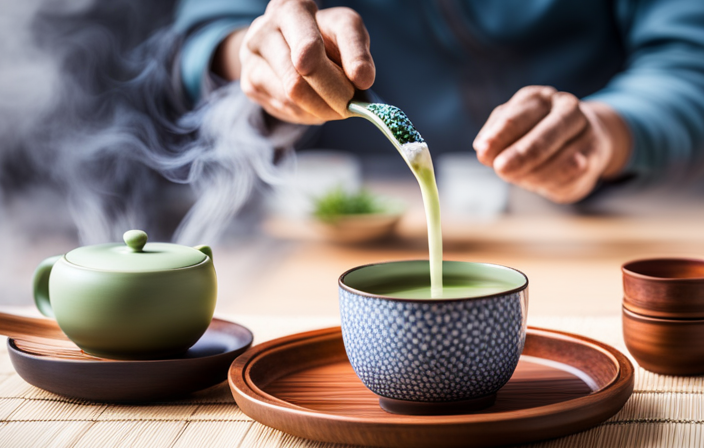
 Green Tea3 months ago
Green Tea3 months agoHow Can You Prepare the Perfect Cup of Green Tea?
